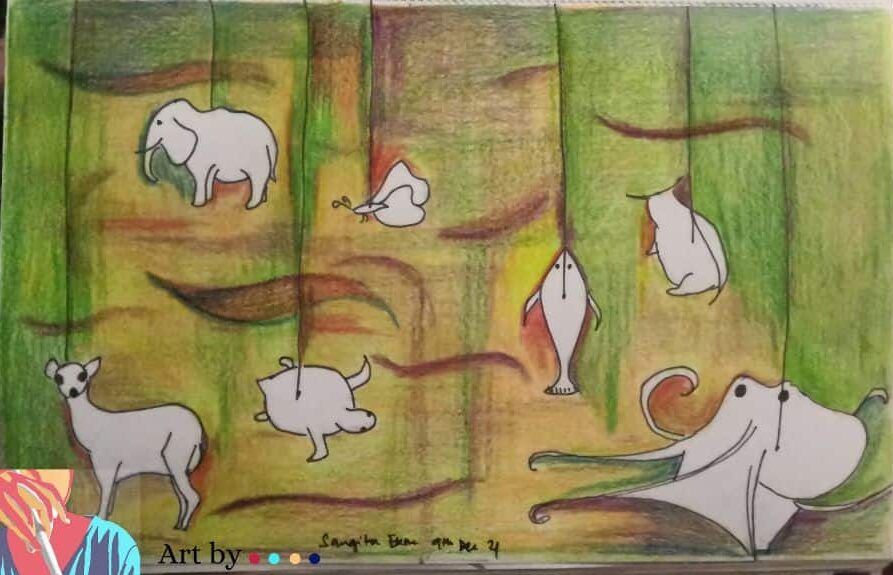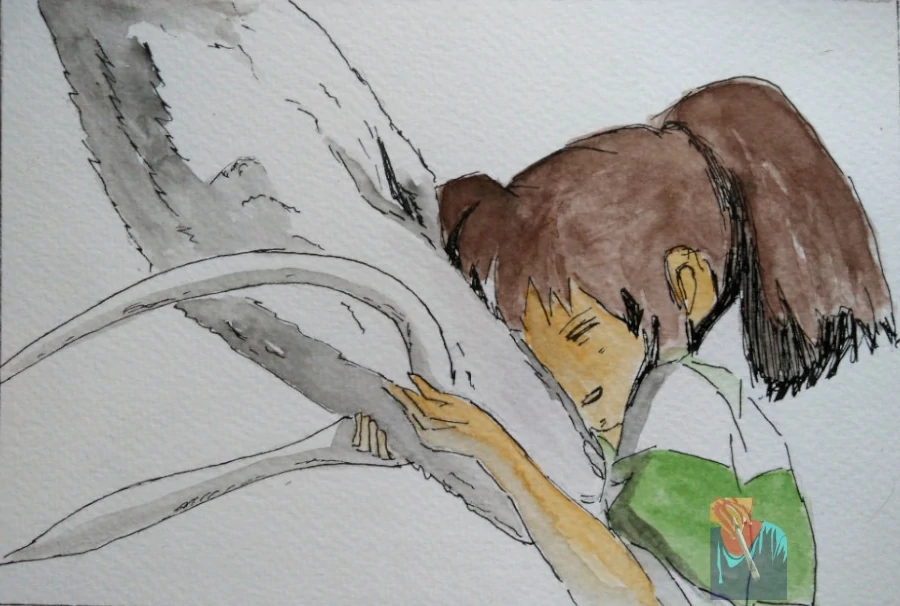Staying true to the minimal theme of the subject, let’s jump straight to the list:
Paperman
Paperman is a Disney short film that was released in 2012.
The film is set in the 1950s-60s era and centers on two strangers who meet at a Manhattan train terminal for a short time. The couple seems to connect but soon gets separated. This animation short imagines that if destiny were to intervene and play a role in connecting the strangers again, how would that unfold?
The film captures the 60s era in its greyscale tone and no color, except for the red lipstick mark that the woman accidentally leaves on one of the papers carried by the man.
Paperman keeps the attention on the duo while the background gives us enough of a 3D perception. It is also one of those Disney films where creators experimented with technology to bring out something new.
It is a 3D film, but it was “retouched” to give it a more 2D animation feel. It carries the smudgy sense of graphite on paper, made possible by the in-house developed software – Meander.
Paperman is a classic boy meets girl story. In about 7 minutes, Disney captures the emotion of how two strangers who might share a moment of connection in a very crowded city may never meet again. Disney won the Academy Award for Best Short Film in 2013 for this film.
AD
The Tale of Princess Kaguya
The Tale of Princess Kaguya is a Studio Ghibli film directed by Isao Takahata. The film is the only animated adaptation based on an ancient Japanese legend – The Tale of the Bamboo Cutter.
Discovered in the bamboo stalk by an old bamboo cutter, Kaguya’s tale is wrapped in intrigue and metaphor. From growing too quickly to exhibiting god-like tendencies, this film offers a lot to unwrap.
Visually, the film is charming. The rural, mountainous regions carry the aura of a watercolor painting, and as the story progresses, we see textures of graphite and crayons in the backdrop.
The aesthetics of the film are minimal and broadly capture the mood of Kaguya through its usage of simple lines and color tones.
Isao Takahata also doesn’t compromise on the animation quality. The film captures many human movements – from the clumsy infant’s crawl to an adolescent’s free run to a Japanese princess’s subtle, customary, and “lady-like” gestures.
Since the film is set in ancient Japan when the society was very hierarchical and the demands of social etiquette were much stricter, we also see the movements of greetings, princely walks, merry-making, and fights, none of which deviate from the rules of timing and space in animation.
The film captures many moods through its minimal color pallet. The viewers traverse from vivid rural greenery to bright pinks of cherry blossoms to ominous dark moods of loss or sadness.
The Tale of Princess Kaguya is a testament that a good story can also work with bare minimum visuals, provided the attention to detail is at the right places.
My Neighbors the Yamadas
Whatever minimal backdrop details you see or imagine for The Tales of Princess Kaguya, drop it by five times, and you have the level of minimalism in My Neighbors the Yamadas.
The film is unique in a non-special way, with marriage at its core theme. It centers on the mundane vignettes of a family of five, depicting their daily routine, tiny adventures, and overall bonding.
Though in the comedy genre, the film also captures deeper nuances of marriage, loneliness, generation gap, and work-life. My Neighbors the Yamadas makes us appreciate the little things in life and occasionally sprinkles Basho’s haiku throughout the film.
Aesthetically, the drawings carry a crayon aura on a solid color backdrop. Each time the viewer has a frame of the Yamada house, we see vague lines of a table or door or just some green squiggles of grass when their dog -Pocho, is in sight.
The creators haven’t bothered to complete the lines of the table or the stairs that must touch the walls. Yet, the characters are complete in themselves with their expressions and other facets of animation.
Takahata-directed My Neighbors the Yamadas adds to the diversity of films from Studio Ghibli.
Ernest & Célestine
French movies have a special place in my heart for the filmmakers’ sheer grasp of visual aesthetics.
It’s been a couple of years since I signed up on Mubi to watch this film for free, and since I reside in India, many European studios are out of reach if they aren’t listed on popular OTT platforms.
Rummaging my memory of this film’s visuals, I remember the usage of pink in the character sketches of Ernest and Célestine. The film’s minimalism is close to The Tales of Princess Kaguya, where the background and characters appear to carry a watercolor wash.
Adapted from a 1982 book series by a Belgian artist – Monique Martin, Ernest & Célestine questions the societal status quo with a simple line – “Bears above and mouse below?” and unpacks the adventure of Ernest(a bear) and Célestine(a mouse) who venture against the rules of both worlds.
The film carries the aesthetics of a typical French film and makes a pleasant watch.
Read: An artist’s role as per “Ernest and Célestine”
Boy and The World
How do you capture the color of music? What do you see when you hear a flute, or a guitar, or bombings?
Hand drawn by the director Alê Abreu, Boy and The World covers the epic adventure of a small boy who grows up without a father and follows every hint around the world, hoping to find him again.
Thoroughly sentimental, the film captures the complex evolution of Latin America under the Industrial Revolution, its power structure, and the murder of native cultures in the name of modernization.
The amount of minimalism in this film depends on the boy’s emotional ride and his life’s simplicity. The film goes back and forth on how many details it wants to add in the background.
When the boy is with his parents, his rural life is simple, and the viewers see him on a starkly white background. We later discover his play area of multi-colored grasses and the rich depiction of wildlife conveyed in bright colors.
The character design is close to how children draw, with added sophistication of proportion.
Boy and The World demands an immediate re-watch. It is the first Brazilian feature film nominated for an Academy Award.
Special Mention – Only Yesterday
I want to close this piece with an underrated feature-length animation film from Isao Takahata – Only Yesterday, based on the Manga of the same name by Hotaru Okamoto.
Charmed by the country life of Japan, a Tokyo girl – Taeko, makes yearly trips to the country, picking safflower and helping a family make rouge out of them during the summers. The film captures her emotional ride as she travels from Tokyo to rural Yamagata and reconnects with nature, people, and her childhood memories. It is a grossly underrated film that exposes the rich, emotional world of Taeko, making her who she is today based on who she was yesterday.
This film’s aesthetics cannot be categorized anywhere close to minimal; however, it distinguishes the present from the past in terms of the details in the frame.
Each time Taeko accessed one of her memories, the background details became lighter, only focusing on what was absolutely necessary. The scene where she runs into her school crush is exceptionally minimal and dreamy.
However, Isao Takahata goes back and forth on how many details he wants to add to the memories. While we see a minimal school playground, her childhood house and school memories are subtly vivid and starkly contrast the vibrant landscapes of slow-moving rural life.
Overall, Only Yesterday is a fantastic watch, a richly emotional story of growth and transformation.
Final Thoughts
It takes 24 frames of drawing to make a second of film. Imagine the work that goes into hand-drawn animation feature-length movies with incredible attention to detail. Think about Yubaba’s contemporary quarters in Spirited Away.
Minimalism is an approach to filmmaking, and when done right, it holds the power to convey complex worlds, emotions, and stories.
In the next part of minimal film visuals, we will also tour the world and probably time travel.
AD



